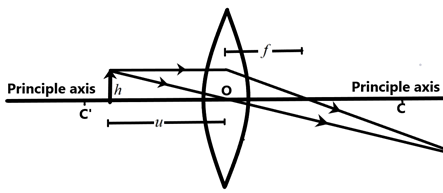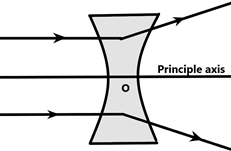
Define the principle axis of a lens.
Answer
483.3k+ views
Hint: We need to analyse and understand the different physical parameters and the imaginary concepts taken into consideration for the identification of the relation between the image formed by a lens due to an object kept at a point from the lens.
Complete answer:
The lenses are transparent materials which are made of materials such as glass or forms of plastics. These are meant to have a higher refractive index as compared to air as a result of which the light falling on them gets refracted according to the Snell’s law. The refraction of the light rays which come from a point lead to the same point to be formed somewhere away from the lens such that the size of the object and image formed as a result of refraction can vary.
The principle axis in a lens is an imaginary line that passes perpendicular to the length of the lens through the optic center. It is the reference line which passes through the center of curvatures on both sides and the geometric center of a spherical lens. All the light rays falling on the lens are compared to this optical axis for ease of geometry.


The light rays coming parallel to the principle axis are meant to form a point image at the focal point of the lens, whereas, a group of slanting light rays form an image on the focal plane.
This is the required solution.
Note:
The principle axes are drawn for all types of mirrors and lenses including the plane mirror and plane lens. For a plane mirror, all the normal will be parallel to the principle axis. For spherical cases, the normal to the light falling on the optic center will be the principle axis itself.
Complete answer:
The lenses are transparent materials which are made of materials such as glass or forms of plastics. These are meant to have a higher refractive index as compared to air as a result of which the light falling on them gets refracted according to the Snell’s law. The refraction of the light rays which come from a point lead to the same point to be formed somewhere away from the lens such that the size of the object and image formed as a result of refraction can vary.
The principle axis in a lens is an imaginary line that passes perpendicular to the length of the lens through the optic center. It is the reference line which passes through the center of curvatures on both sides and the geometric center of a spherical lens. All the light rays falling on the lens are compared to this optical axis for ease of geometry.


The light rays coming parallel to the principle axis are meant to form a point image at the focal point of the lens, whereas, a group of slanting light rays form an image on the focal plane.
This is the required solution.
Note:
The principle axes are drawn for all types of mirrors and lenses including the plane mirror and plane lens. For a plane mirror, all the normal will be parallel to the principle axis. For spherical cases, the normal to the light falling on the optic center will be the principle axis itself.
Recently Updated Pages
Master Class 12 Business Studies: Engaging Questions & Answers for Success

Master Class 12 English: Engaging Questions & Answers for Success

Master Class 12 Social Science: Engaging Questions & Answers for Success

Master Class 12 Chemistry: Engaging Questions & Answers for Success

Class 12 Question and Answer - Your Ultimate Solutions Guide

Master Class 11 Economics: Engaging Questions & Answers for Success

Trending doubts
Draw a labelled sketch of the human eye class 12 physics CBSE

a Tabulate the differences in the characteristics of class 12 chemistry CBSE

Which one of the following is a true fish A Jellyfish class 12 biology CBSE

Why is the cell called the structural and functional class 12 biology CBSE

Differentiate between homogeneous and heterogeneous class 12 chemistry CBSE

Write the difference between solid liquid and gas class 12 chemistry CBSE




